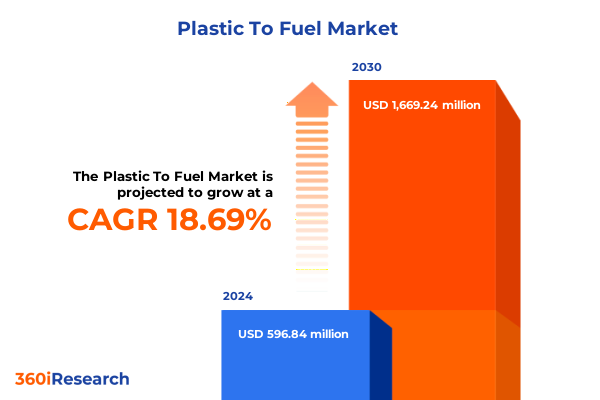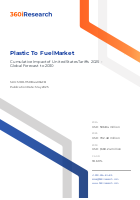The Plastic To Fuel Market size was estimated at USD 596.84 million in 2024 and expected to reach USD 702.48 million in 2025, at a CAGR 18.69% to reach USD 1,669.24 million by 2030.

Introduction to the Plastic-to-Fuel Market Opportunity
The global plastic-to-fuel industry is at an inflection point, driven by mounting environmental regulations, accelerating plastic waste generation, and the urgent need for sustainable energy solutions. As policymakers tighten restrictions on landfill disposal and single-use plastics, innovators are scaling technologies that convert discarded polymers into valuable fuels. Simultaneously, energy markets seek alternative sources to complement dwindling fossil reserves and mitigate carbon footprints. Against this backdrop, plastic-to-fuel emerges as a dual-benefit strategy: reducing plastic pollution while supplying diesel, gasoline, kerosene, and fuel oil for diverse applications. With catalytic conversion and pyrolysis processes gaining technical maturity, stakeholders-from chemical engineers to energy buyers-must navigate evolving feedstock mixes, policy shifts, and competitive dynamics. This executive summary distills critical insights into recent transformational shifts, regional nuances, and company-led advancements. It equips decision-makers with actionable intelligence to harness plastic-to-fuel’s full potential.
Transformative Shifts Driving Growth in Plastic-to-Fuel
In recent years, the plastic-to-fuel landscape has undergone profound transformation. Technological breakthroughs in catalytic conversion have improved product yields and energy efficiency, while next-generation pyrolysis reactors achieve higher throughput and lower capital costs. Public–private partnerships have emerged, financing demonstration projects that validate commercial viability. Meanwhile, investors are channeling growth capital into ventures that bridge chemical recycling with renewable energy demand. On the policy front, extended producer responsibility mandates and plastic taxes have reshaped supply chains, encouraging waste collectors and recyclers to seek chemical routes when mechanical recycling reaches its limits. Concurrently, corporate sustainability commitments-particularly among transportation and manufacturing majors-are driving procurement of alternative fuels with favorable life-cycle emissions. Taken together, these shifts are accelerating market adoption and setting the stage for rapid scale-up.
Analyzing the Cumulative Impact of U.S. Tariffs Implemented in 2025
The imposition of new tariffs on imported plastics and fuels within the United States in 2025 has introduced both challenges and opportunities. Higher duties on low-value scrap plastics have pressured feedstock costs, incentivizing producers to secure domestic waste streams or invest in sorting and pre-treatment facilities. At the same time, import levies on refined fuel products have improved the competitive position of locally produced diesel, gasoline, fuel oil, and kerosene derived from waste plastics. As a result, processors are realigning logistics networks to minimize tariff exposure, often co-locating recycling and conversion assets near major source points such as urban centers and port facilities. Despite short-term margin compression for feedstock suppliers, the broader policy framework has stimulated vertical integration and encouraged technology licensing agreements. Ultimately, these tariff measures are catalyzing consolidation among operators that can navigate regulatory complexity and optimize end-to-end value chains.
Key Segmentation Insights into Feedstock, Fuel, Process and End Use
The market’s structural complexity becomes clear when examining key segmentation dimensions. Based on feedstock type, stakeholders evaluate mixed plastics alongside more uniform streams of polyethylene, polypropylene, and polystyrene, each presenting distinct contaminant profiles and calorific values. Converting mixed plastics often requires robust sorting or enhanced reactor designs to handle feed inconsistencies, whereas polyethylene and polypropylene deliver higher diesel yields. Polystyrene, with its aromatic-rich composition, favors gasoline and fuel oil outputs but demands specialized catalysts. From a fuel perspective, diesel remains the predominant product due to its broad industrial and transportation applications, while fuel oil addresses power generation needs. Gasoline and kerosene segments are gaining traction, driven by aviation’s push for sustainable drop-in fuels and niche industrial processes. Process selection further delineates market players: catalytic conversion offers fast reaction times and high product selectivity, whereas pyrolysis systems provide feedstock flexibility and simpler reactor configurations. End-use dynamics overlay these technical factors. Industrial manufacturing plants often require onsite fuel solutions, residential energy users value small-scale pyrolysis units for heating, and transportation operators-spanning automotive, aviation, marine, and rail sectors-increasingly seek circular fuel sources. By understanding how these segmentation facets interrelate, leaders can tailor investments to capture the most lucrative market pockets.
This comprehensive research report categorizes the Plastic To Fuel market into clearly defined segments, providing a detailed analysis of emerging trends and precise revenue forecasts to support strategic decision-making.
- Feedstock Type
- Fuel Type
- Process
- End Use
Key Regional Insights Shaping Deployment Strategies
Regional considerations play an outsized role in shaping project economics and deployment velocity. In the Americas, abundant municipal waste streams and supportive federal grants for advanced recycling have attracted both domestic and international investors. Infrastructure upgrades in North America, complemented by robust logistical corridors, facilitate large-scale catalytic conversion complexes. In Latin America, informal waste collection presents challenges but also opportunities for community-based feedstock aggregation models. The Europe, Middle East & Africa region is characterized by stringent waste-management regulations and ambitious circularity goals. Here, high plastic disposal fees and carbon pricing accelerate technology adoption, while cross-border collaborations fund pilot facilities, particularly in Western Europe. Energy demand growth in the Middle East is prompting experimental projects that convert industrial plastic scrap into fuel oil for onsite power generation. Asia-Pacific exhibits a diverse landscape: East Asian markets leverage advanced material-handling systems and substantial R&D investments, whereas Southeast Asian nations balance rapid urbanization with resource constraints, giving rise to modular pyrolysis plants. In Oceania, supply limitations spur import-substitution strategies, encouraging local conversion ventures. These regional insights underscore the necessity of a tailored approach, from feedstock sourcing to technology deployment and off-take partnerships.
This comprehensive research report examines key regions that drive the evolution of the Plastic To Fuel market, offering deep insights into regional trends, growth factors, and industry developments that are influencing market performance.
- Americas
- Asia-Pacific
- Europe, Middle East & Africa
Key Company Insights Driving Technological Leadership
A vibrant ecosystem of technology providers, project developers, and engineering firms is driving rapid innovation across the plastic-to-fuel value chain. Agilyx and Alterra Energy, LLC have pioneered industrial-scale pyrolysis installations, showcasing reliable feedstock handling and consistent product quality. Amogy Inc. and Anellotech, Inc. are advancing catalytic platforms that target high-purity gasoline and specialty fuel outputs. Blue Planet Environmental Solutions Pte Ltd and Encina focus on modular solutions that deliver swift ROI for off-grid applications. Enerkem Inc. and Envion have successfully integrated chemical recycling with municipal waste management, demonstrating closed-loop circularity. Geminor and GreenMantra Technologies Inc. are forging partnerships with polymer producers to secure steady feedstock volumes. JBI Inc., Klean Industries Inc., and Lummus Technology LLC provide turnkey engineering, procurement, and construction services, enabling rapid project realization. Mura Technology Limited and Neste emphasize sustainability credentials, aligning conversion processes with rigorous life-cycle assessments. Nexus Circular LLC, Plastic 2 Green Inc., Plastic2Oil Inc., PolyCycl, and Quantafuel A/S offer diversified technology portfolios, catering to varied feedstock compositions and product specifications. Renewlogy Inc., RES Polyflow, and Resynergi, Inc. specialize in localized pyrolysis units, while Technip Energies, Vadxx Energy, and Waste Energy Corp. deliver integrated facilities that combine waste sorting, conversion, and fuel distribution. Together, these companies illustrate a competitive landscape defined by strategic alliances, licensing agreements, and continuous process improvements.
This comprehensive research report delivers an in-depth overview of the principal market players in the Plastic To Fuel market, evaluating their market share, strategic initiatives, and competitive positioning to illuminate the factors shaping the competitive landscape.
- Agilyx
- Alterra Energy, LLC
- Amogy Inc.
- Anellotech, Inc.
- Blue Planet Environmental Solutions Pte Ltd
- Encina
- Enerkem Inc.
- Envion
- Geminor
- GreenMantra Technologies Inc.
- JBI Inc.
- Klean Industries Inc.
- Lummus Technology LLC
- Mura Technology Limited
- Neste
- Nexus Circular LLC
- Plastic 2 Green Inc.
- Plastic2Oil Inc.
- PolyCycl
- Quantafuel A/S
- Renewlogy Inc.
- RES Polyflow
- Resynergi, Inc
- Technip Energies
- Vadxx Energy
- Waste Energy Corp
Actionable Recommendations for Industry Leaders to Accelerate Growth
Industry leaders can capitalize on emerging opportunities by adopting a three-pronged strategic approach. First, securing diverse feedstock streams through partnerships with waste collectors and municipalities will mitigate supply risks and optimize conversion efficiency. Second, integrating real-time analytics and digital twins into process operations will improve yield predictability, reduce downtime, and enhance catalyst management, thereby driving operational excellence. Third, forging long-term offtake agreements with industrial manufacturers, power generators, and transportation fleets-spanning automotive, aviation, marine, and rail sectors-will provide stable revenue streams and facilitate project financing. Additionally, advancing research collaborations with academic institutions and testing pilots for novel reactor designs will keep firms at the cutting edge of catalytic and pyrolysis technologies. Finally, engaging proactively with policymakers to shape incentive frameworks and standardization protocols will secure favorable market conditions and accelerate technology adoption.
Explore AI-driven insights for the Plastic To Fuel market with ResearchAI on our online platform, providing deeper, data-backed market analysis.
Ask ResearchAI anything
World's First Innovative Al for Market Research
Conclusion: Embracing Circularity Through Plastic-to-Fuel Innovation
The plastic-to-fuel sector stands poised to redefine waste management and energy production paradigms. Through converging technological innovations and policy support, chemical recycling has emerged as a viable alternative to landfilling and incineration. By leveraging feedstock segmentation insights, regional dynamics, and best-in-class operational strategies, stakeholders can navigate the complexity of this evolving market. Collaboration across the value chain-from waste aggregators to end-use customers-will be essential to establish robust supply protocols and optimize asset utilization. As tariff landscapes and regulatory priorities continue to shift, proactive adaptation will determine which players emerge as industry benchmarks. In sum, the convergence of environmental imperatives and energy security concerns positions plastic-to-fuel conversion as a transformative solution, ripe for scale-up and integration into circular economy frameworks.
This section provides a structured overview of the report, outlining key chapters and topics covered for easy reference in our Plastic To Fuel market comprehensive research report.
- Preface
- Research Methodology
- Executive Summary
- Market Overview
- Market Dynamics
- Market Insights
- Cumulative Impact of United States Tariffs 2025
- Plastic To Fuel Market, by Feedstock Type
- Plastic To Fuel Market, by Fuel Type
- Plastic To Fuel Market, by Process
- Plastic To Fuel Market, by End Use
- Americas Plastic To Fuel Market
- Asia-Pacific Plastic To Fuel Market
- Europe, Middle East & Africa Plastic To Fuel Market
- Competitive Landscape
- ResearchAI
- ResearchStatistics
- ResearchContacts
- ResearchArticles
- Appendix
- List of Figures [Total: 24]
- List of Tables [Total: 239 ]
Call to Action: Contact Ketan Rohom to Access the Full Market Research Report
To explore these insights in depth and secure competitive advantage, connect with Ketan Rohom, Associate Director, Sales & Marketing. He can guide you through the comprehensive market research report, tailored to your strategic objectives, and facilitate data-driven decisions that capitalize on plastic-to-fuel’s growth trajectory. Engage today to unlock actionable intelligence and partner in driving the circular energy transition.

- How big is the Plastic To Fuel Market?
- What is the Plastic To Fuel Market growth?
- When do I get the report?
- In what format does this report get delivered to me?
- How long has 360iResearch been around?
- What if I have a question about your reports?
- Can I share this report with my team?
- Can I use your research in my presentation?




